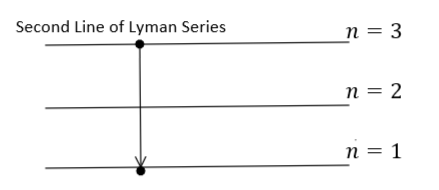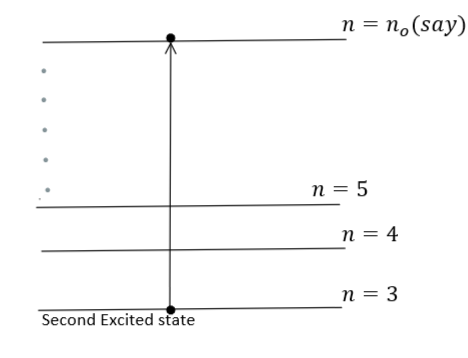
The photon radiated from hydrogen corresponding to the second line of Lyman series is absorbed by a hydrogen-like atom $X$ in the second excited state. Then, the hydrogen-like atom $X$ makes a transition to ${n^{th}}$ orbit
A. $X = H{e^ + },\,\,n = 4$
B. $X = L{i^{ + + }},\,\,n = 6$
C. $X = H{e^ + },\,\,n = 6$
D. $X = L{i^{ + + }},\,\,n = 9$
Answer
134.7k+ views
Hint:In this problem, to determine the hydrogen-like atom $X$ that makes a transition to ${n^{th}}$ orbit from the second excited state, we have to evaluate the energy released during the transition of hydrogen and since the same energy is absorbed by $X$ during its transition (that is released before) therefore, we can compare the energies obtained during the two transitions to get the correct solution.
Formula used:
The formula used in this problem is of the energy obtained due to the transition between two energy levels which is given as: -
$E = - 13.6{Z^2}\left( {\dfrac{1}{{n_1^2}} - \dfrac{1}{{n_2^2}}} \right)$
Here, ${n_1}{\text{ }}and{\text{ }}{n_2}$ are the principal quantum numbers for high energy level and low energy level respectively.
Complete step by step solution:
We know that the expression for obtaining energy during the transition between two energy levels can be stated as: -
$E = - 13.6{Z^2}\left( {\dfrac{1}{{n_1^2}} - \dfrac{1}{{n_2^2}}} \right)\,\,\,\,\,\,\,\,\,\,\,\,\,\,\,\,\,...\,(1)$
It is given that the photon radiated from hydrogen $(Z = 1)$ corresponding to the second line of the Lyman series. Therefore, the transition will be from ${n_1} = 3$ to ${n_2} = 1$ as shown in the figure:

During this transition, the energy will be released which can be calculated using equation $(1)$ as: -
${E_{released}} = - 13.6{\left( 1 \right)^2}\left( {\dfrac{1}{{{3^2}}} - \dfrac{1}{{{1^2}}}} \right) = - 13.6\left( {\dfrac{1}{{{3^2}}} - \dfrac{1}{{{1^2}}}} \right)\,\,\,\,\,\,\,\,\,\,\,\,\,\,\,\,\,\,\,\,\,\,\,\,\,\,\,\,\,\,\,\,...\,(2)$
$ \Rightarrow {E_{released}} = - 13.6\left( {\dfrac{1}{9} - \dfrac{1}{1}} \right) = 13.6\left( {\dfrac{8}{9}} \right)\,eV \\ $
Now, the same amount of energy is absorbed by a hydrogen-like atom $X\,(Z = Z)$ in the second excited state that makes a transition to ${n^{th}}$ orbit $(say\,{n_o})$ as described with the help of below-given diagram: -

During this transition, the energy is absorbed. Therefore, using equation $(1)$, we get
${E_{absorbed}} = - 13.6{\left( Z \right)^2}\left( {\dfrac{1}{{{n_o}^2}} - \dfrac{1}{{{3^2}}}} \right) = - 13.6\left( {\dfrac{{{Z^2}}}{{{n_o}^2}} - \dfrac{{{Z^2}}}{{{3^2}}}} \right)\,\,\,\,\,\,\,\,\,\,\,\,\,\,...\,(3)$
As the energy absorbed by hydrogen-like atom $X$ is same as the energy released by hydrogen hence, on comparing equations $(2)$ and $(3)$ , we get
${E_{released}} = {E_{absorbed}}$
$\Rightarrow - 13.6\left( {\dfrac{1}{{{3^2}}} - \dfrac{1}{{{1^2}}}} \right) = - 13.6\left( {\dfrac{{{Z^2}}}{{{n_o}^2}} - \dfrac{{{Z^2}}}{{{3^2}}}} \right)$
On comparing both the sides, we get
$\dfrac{1}{{{3^2}}} = \dfrac{{{Z^2}}}{{{n_o}^2}}\,\,and\,\,\dfrac{1}{{{1^2}}} = \dfrac{{{Z^2}}}{{{3^2}}}$
$\Rightarrow \dfrac{1}{3} = \dfrac{Z}{{{n_o}}}\,\,and\,\,1 = \dfrac{Z}{3}$
Simplifying both the equations, we get $Z = 3$ and ${n_o} = 9$. Thus, the hydrogen-like atom $X$ is Lithium ion $L{i^{ + + }}(Z = 3)$ that makes a transition to ${9^{th}}$ orbit from second excited state i.e., $X = L{i^{ + + }},\,\,n = 9$.
Hence, the correct option is D.
Note: In this kind of problem, we can answer the problem by using the concept of $\dfrac{Z}{n}$ ratio like it is given that energy released in transition of hydrogen is same as that of energy absorbed in the transition of hydrogen-like atom and since transition of hydrogen is from ${n_1} = 3$ to ${n_2} = 1$ , then $3 \to 1$ transition in $H$ would give same energy as the $3 \times 3 \to 1 \times 3$ transition in $L{i^{ + + }}$ to main same $\dfrac{Z}{n}$ ratio.
Formula used:
The formula used in this problem is of the energy obtained due to the transition between two energy levels which is given as: -
$E = - 13.6{Z^2}\left( {\dfrac{1}{{n_1^2}} - \dfrac{1}{{n_2^2}}} \right)$
Here, ${n_1}{\text{ }}and{\text{ }}{n_2}$ are the principal quantum numbers for high energy level and low energy level respectively.
Complete step by step solution:
We know that the expression for obtaining energy during the transition between two energy levels can be stated as: -
$E = - 13.6{Z^2}\left( {\dfrac{1}{{n_1^2}} - \dfrac{1}{{n_2^2}}} \right)\,\,\,\,\,\,\,\,\,\,\,\,\,\,\,\,\,...\,(1)$
It is given that the photon radiated from hydrogen $(Z = 1)$ corresponding to the second line of the Lyman series. Therefore, the transition will be from ${n_1} = 3$ to ${n_2} = 1$ as shown in the figure:

During this transition, the energy will be released which can be calculated using equation $(1)$ as: -
${E_{released}} = - 13.6{\left( 1 \right)^2}\left( {\dfrac{1}{{{3^2}}} - \dfrac{1}{{{1^2}}}} \right) = - 13.6\left( {\dfrac{1}{{{3^2}}} - \dfrac{1}{{{1^2}}}} \right)\,\,\,\,\,\,\,\,\,\,\,\,\,\,\,\,\,\,\,\,\,\,\,\,\,\,\,\,\,\,\,\,...\,(2)$
$ \Rightarrow {E_{released}} = - 13.6\left( {\dfrac{1}{9} - \dfrac{1}{1}} \right) = 13.6\left( {\dfrac{8}{9}} \right)\,eV \\ $
Now, the same amount of energy is absorbed by a hydrogen-like atom $X\,(Z = Z)$ in the second excited state that makes a transition to ${n^{th}}$ orbit $(say\,{n_o})$ as described with the help of below-given diagram: -

During this transition, the energy is absorbed. Therefore, using equation $(1)$, we get
${E_{absorbed}} = - 13.6{\left( Z \right)^2}\left( {\dfrac{1}{{{n_o}^2}} - \dfrac{1}{{{3^2}}}} \right) = - 13.6\left( {\dfrac{{{Z^2}}}{{{n_o}^2}} - \dfrac{{{Z^2}}}{{{3^2}}}} \right)\,\,\,\,\,\,\,\,\,\,\,\,\,\,...\,(3)$
As the energy absorbed by hydrogen-like atom $X$ is same as the energy released by hydrogen hence, on comparing equations $(2)$ and $(3)$ , we get
${E_{released}} = {E_{absorbed}}$
$\Rightarrow - 13.6\left( {\dfrac{1}{{{3^2}}} - \dfrac{1}{{{1^2}}}} \right) = - 13.6\left( {\dfrac{{{Z^2}}}{{{n_o}^2}} - \dfrac{{{Z^2}}}{{{3^2}}}} \right)$
On comparing both the sides, we get
$\dfrac{1}{{{3^2}}} = \dfrac{{{Z^2}}}{{{n_o}^2}}\,\,and\,\,\dfrac{1}{{{1^2}}} = \dfrac{{{Z^2}}}{{{3^2}}}$
$\Rightarrow \dfrac{1}{3} = \dfrac{Z}{{{n_o}}}\,\,and\,\,1 = \dfrac{Z}{3}$
Simplifying both the equations, we get $Z = 3$ and ${n_o} = 9$. Thus, the hydrogen-like atom $X$ is Lithium ion $L{i^{ + + }}(Z = 3)$ that makes a transition to ${9^{th}}$ orbit from second excited state i.e., $X = L{i^{ + + }},\,\,n = 9$.
Hence, the correct option is D.
Note: In this kind of problem, we can answer the problem by using the concept of $\dfrac{Z}{n}$ ratio like it is given that energy released in transition of hydrogen is same as that of energy absorbed in the transition of hydrogen-like atom and since transition of hydrogen is from ${n_1} = 3$ to ${n_2} = 1$ , then $3 \to 1$ transition in $H$ would give same energy as the $3 \times 3 \to 1 \times 3$ transition in $L{i^{ + + }}$ to main same $\dfrac{Z}{n}$ ratio.
Recently Updated Pages
JEE Main 2025 Session 2 Form Correction (Closed) – What Can Be Edited

What are examples of Chemical Properties class 10 chemistry JEE_Main

JEE Main 2025 Session 2 Schedule Released – Check Important Details Here!

JEE Main 2025 Session 2 Admit Card – Release Date & Direct Download Link

JEE Main 2025 Session 2 Registration (Closed) - Link, Last Date & Fees

JEE Mains Result 2025 NTA NIC – Check Your Score Now!

Trending doubts
JEE Main 2025 Session 2: Application Form (Out), Exam Dates (Released), Eligibility, & More

JEE Main 2025: Conversion of Galvanometer Into Ammeter And Voltmeter in Physics

JEE Main 2025: Derivation of Equation of Trajectory in Physics

Wheatstone Bridge for JEE Main Physics 2025

Degree of Dissociation and Its Formula With Solved Example for JEE

Electric field due to uniformly charged sphere class 12 physics JEE_Main

Other Pages
JEE Advanced Marks vs Ranks 2025: Understanding Category-wise Qualifying Marks and Previous Year Cut-offs

Diffraction of Light - Young’s Single Slit Experiment

Dual Nature of Radiation and Matter Class 12 Notes: CBSE Physics Chapter 11

Electric Field Due to Uniformly Charged Ring for JEE Main 2025 - Formula and Derivation

Elastic Collisions in One Dimension - JEE Important Topic

Formula for number of images formed by two plane mirrors class 12 physics JEE_Main




